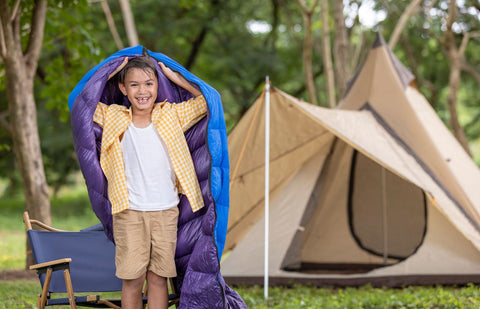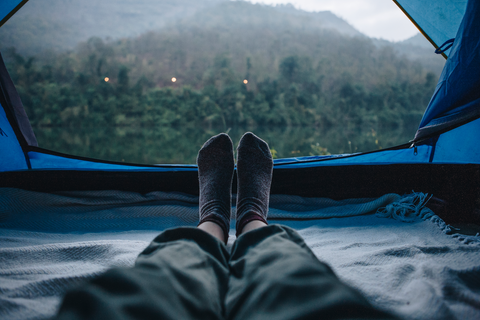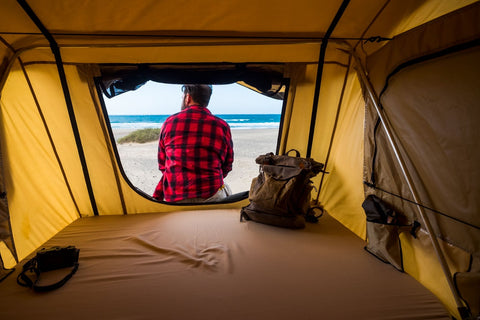Camping Sleepwear: What to Wear to Sleep When Camping?
Whether you're a seasoned camper or new to the outdoor adventure scene, one thing we can all agree on is the importance of a good night's sleep when on a camping trip. But when it comes to getting that much-needed shut-eye in the wilderness, your choice of sleepwear plays a crucial role. It's not just about looking good; it's about feeling comfortable, staying functional, and being ready for whatever Mother Nature throws your way.
In this blog, we'll dive into the world of camping sleepwear and explore what to wear camping when sleeping under the stars. Let's dive right in.
The Importance of Choosing the Right Sleepwear
You might wonder, "Why does it even matter what I wear to bed while camping?" Here are some compelling reasons why selecting the right sleepwear is vital:
1) Comfort is Key
Credit: Envato Elements/ Simol147
Camping often involves sleeping on uneven terrain, in varying weather conditions, and sometimes even in a sleeping bag. In such situations, comfort is crucial. The right sleepwear can help you stay comfortable and sleep soundly by providing insulation, breathability, and a cozy feel against your skin. Uncomfortable sleepwear can lead to restless nights and leave you groggy and fatigued during the day.
2) Temperature Regulation
Outdoor temperatures can fluctuate dramatically, especially in the wilderness. Whether it's a hot summer night or a chilly winter evening, the appropriate sleepwear will help regulate your body temperature, ensuring you stay neither too hot nor too cold.
3) Insect and Wildlife Protection

Credit: Envato Elements/ Simol147
Depending on your camping location, you may encounter insects, ticks, or other wildlife. The right sleepwear will provide some level of protection against bites and scratches, thereby ensuring your overall safety.
4) Adaptability to Changing Conditions
Weather can be unpredictable, and it's not uncommon for campers to experience sudden changes in conditions. The right sleepwear can help you quickly adapt to these changes without disrupting your sleep.
5) Psychological Comfort

Credit: Envato Elements/ Sotnikov_Misha
Lastly, the right sleepwear can provide a psychological sense of security and well-being. When you feel comfortable and prepared for the elements, you're more likely to relax and enjoy your camping experience to the fullest.
What to Wear to Bed When Camping
Now that you the importance of choosing the right sleepwear for camping, let's explore some practical options for what to wear to bed when you're out in the wilderness:
1) Base Layers
Credit: Envato Elements/ thanyapatm
Top: Start with moisture-wicking base layers made of synthetic materials. These materials help keep sweat away from your skin and provide insulation. Avoid cotton, as it retains moisture and can make you feel clammy.
Bottoms: For your lower half, opt for moisture-wicking base layer pants or leggings. These can provide added insulation, especially on colder nights. Look for options that fit snugly without being too tight to ensure optimal insulation.
Thermal Underwear: Thermal or long underwear is an excellent choice for cold nights. Look for options made from materials like merino wool or synthetic blends for maximum retention of body heat.
2) Mid-Layers (Optional)
Depending on the weather, you might want to add an insulating mid-layer like a fleece top or bottoms. This provides extra warmth in cooler conditions.
3) Outer Layers
Credit: Envato Elements/ sokorspace
Sleeping Bags and Sleeping Pads: Choose a suitable sleeping bag and sleeping pad based on the season and expected temperature. Your sleepwear should complement the sleeping bag's insulation; for example, if you have a warm sleeping bag, you may not need heavy sleepwear.
Pajamas or Sleepwear: Lightweight, loose-fitting pajamas or sleepwear made of breathable materials are a good choice. Opt for long sleeves and pants to provide some protection against insects and abrasions. These work well as car camping clothes as well.
Fleece or Insulated Jacket: A lightweight fleece or insulated jacket can add extra warmth when temperatures drop. Choose one that's not too bulky so it doesn't restrict your movement.
4) Socks and Headwear
Wear moisture-wicking socks to keep your feet dry and comfortable. In colder weather, consider thermal socks.
5) Footwear
Credit: Envato Elements/ Rawpixel
Although not part of your sleepwear, consider wearing clean, slip-on camp shoes if you need to get up during the night. This will help you avoid tracking dirt and moisture into your sleeping bag.
6) Accessories
If you're camping in extremely cold conditions, don't forget to wear gloves or mittens to keep your hands warm.
Tips for Choosing the Right Camping Sleepwear
Selecting the ideal sleepwear for camping can be a bit overwhelming with all the options available. To make the process easier, here are some helpful tips to guide you in choosing the right camping sleepwear:
1) Check the Weather Forecast
Credit: Envato Elements/ ajbuenavista
Before packing your sleepwear, always check the weather forecast for your camping destination and be prepared to adjust your sleepwear accordingly. Hot weather may require lighter and more breathable options, while cold weather calls for additional insulation.
2) Check for Comfort
Comfort is crucial when it comes to sleepwear. Ensure your sleepwear allows for freedom of movement and doesn't have any uncomfortable seams or tags that could bother you while you sleep.
3) Pack Spare Sleepwear
Credit: Envato Elements/ simonapilolla
It's always a good idea to have a backup set of sleepwear, especially on longer trips. Unexpected spills, tears, or sudden weather changes can make a spare set invaluable.
4) Avoid Cotton in Cold Weather
While cotton is a comfortable material, it's not the best choice for cold-weather camping. Cotton tends to retain moisture and can make you feel chilly. Stick to moisture-wicking, insulating materials for cold conditions.
5) Think About Insect Protection
Credit: Envato Elements/ leungchopan
If your camping destination is known for insects or ticks, consider sleepwear that offers some level of protection, such as long sleeves and pants with tight-fitting cuffs or insect-repellent fabrics.
Sleepwear Tips for Different Camping Seasons
Camping isn't limited to just one season; it can be enjoyed year-round. Each season comes with its unique challenges and weather conditions, so your choice of sleepwear should adapt accordingly. Here are some essential sleepwear tips for different camping seasons:
1) Summer Camping Trip
Credit: Envato Elements/ kitzstocker
Minimal Layers: Since summer nights tend to be warmer, you may not need multiple layers. A moisture-wicking base layer and shorts or lightweight sleep pants might be sufficient.
Ventilation: Consider wearing sleeping clothes with good ventilation and choosing the right sleeping bag with a zipper that allows for airflow when needed.
Insect Protection: Insect-repellent sleepwear can be especially useful during summer camping to guard against pesky bugs. Whether you're on a tent or car camping trip, this tip is valuable.
2) Fall Camping Trip
Layering is Key: Fall brings cooler temperatures, so layering becomes crucial. Start with moisture-wicking base layers and add insulating layers as needed.
Long Sleeves and Pants: Long-sleeve shirts and pants provide extra warmth and also offer protection against ticks and mosquitoes.
Hat and Gloves: As the nights get chillier, don't forget to pack a warm hat and gloves to retain heat.
3) Winter Camping Trip
Credit: Envato Elements/ PaulSchlemmer
Thermal Insulation: For winter camping, prioritize thermal or merino wool base layers for maximum insulation.
Insulated Jacket: A well-insulated jacket or down sweater is essential to trap warmth. Make sure it's not too tight to allow for proper circulation.
Thick Socks: In extremely cold conditions, consider wearing thick, insulated socks to keep your feet warm.
Balaclava or Neck Gaiter: These can help protect your face and neck from the cold and retain heat.
4) Spring Camping Trip
Versatility: Spring can bring fluctuating temperatures, so versatile sleepwear options are key. Layering and adaptable clothing are your friends.
Rain Protection: Depending on your location, spring can be rainy. Ensure your sleepwear is at least water-resistant or pack rain gear separately.
Be Prepared for Surprises: Spring weather can be unpredictable, so it's wise to have both warm and cool-weather sleepwear on hand.
Summary
Selecting the right sleepwear for tent camping is essential to ensure a restful night's sleep under the stars. By following the tips above, you can make your camping experience more enjoyable.
And, for added peace of mind, consider Emergency USA, your essential emergency camping gear. Emergency USA is designed to make your camping experience safer and more convenient. Shop with us today.









